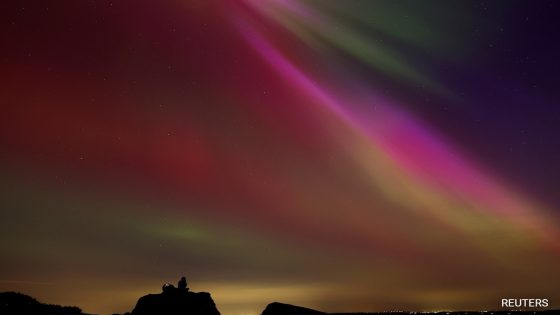The chance of solar flares coming out at this time are more
New Delhi:
A celestial event is unfolding as solar flares and coronal mass ejections dazzle the skies, potentially extending the spectacle as far south as Alabama and Northern California in the US.
However, alongside the beautiful auroras, there are concerns over potential disruptions to Earth’s communications networks this weekend.
Explaining the phenomenon, a scientist said solar flares are common and so happen all the time.
“It happens when the sun gets to the peak of its activity of the 11-year circle. After every 11 years, the activity of the sun goes from high to low and in 2025 the activity is going to be at its peak,” scientific officer at the Institute for Plasma Research Centre Dr Ravi AV Kumar told news agency ANI.
The rarity of this solar storm harks back to October 2003, according to the US National Oceanic and Atmospheric Administration’s (NOAA) space weather prediction centre, marking a significant celestial occurrence not seen in many years.
The chance of solar flares coming out at this time are more, as these are highly charged particles of plasma which can travel at very high velocities, the scientist said. The faster these particles move the more dangerous they are, he added.
“Since these are charged particles from the Sun, they can get deflected from the Earth’s magnetic field. Some of these deflected particles can come to polar regions of the Earth, which then interact with gas molecules in the upper atmosphere,” Dr Kumar said.
“… They produce a colour called Aurora. When there is a very strong solar flare like the one which happened yesterday, combined with the Earth’s atmosphere and magnetic field, it produces Auroras. People are very fortunate to even see this right up to northern Italy,” Dr Kumar said.
“The Aurora could also be seen in Ladakh… Flares come and go; they don’t affect us directly but can affect our day-to-day activities like communication as the satellites can be disrupted. Satellite TV signals and radio communication could also get disrupted,” the scientist said.
#WATCH | Ahmedabad Gujarat: On Solar Storm, Scientific Officer of Institute for Plasma Research Centre Dr Ravi A V Kumar says, “Solar Flares are very common, it happens all the time…It happens when the sun gets to the peak of its activity of 11-year circle…After every 11… pic.twitter.com/8w8ejhiQd4
— ANI (@ANI) May 11, 2024
Solar cycles, characterised by fluctuations in sunspot activity, dictate the sun’s behaviour, transitioning from periods of relative calm to intense activity and back again. The current cycle, Solar Cycle 25, has exceeded expectations in terms of activity, with NOAA’s Space Weather Prediction Center noting an uptick in sunspot counts compared to the previous cycle’s peak.
With inputs from ANI
Source Agencies


